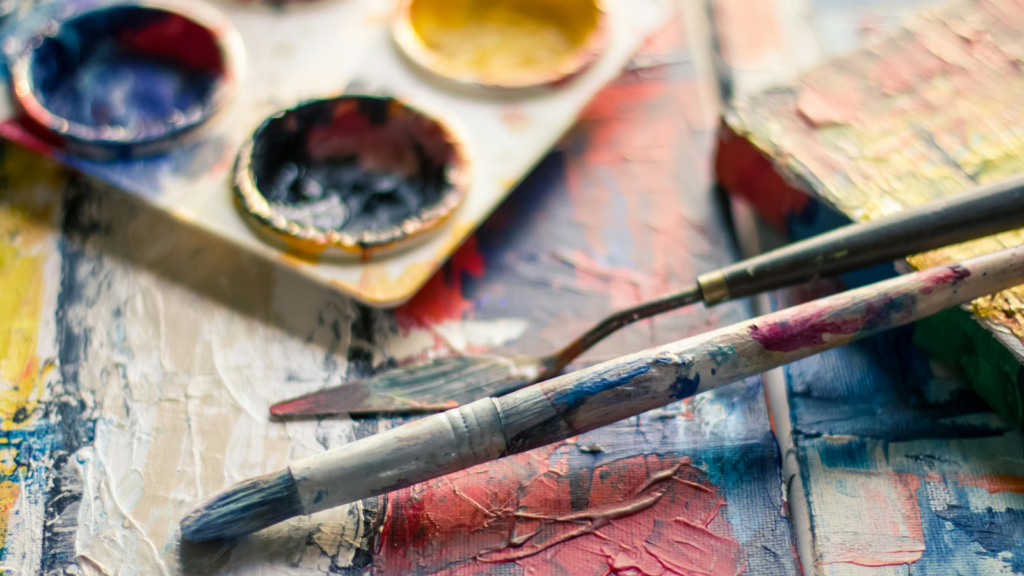Whether you’re a seasoned crafter or a DIY enthusiast venturing into wood craft, knowing what paint to use can make all the difference. From acrylics to enamels, each type has its unique characteristics and applications.
Let’s delve into the world of paints and explore how to select the best one for your wood crafts. This guide will help you navigate through the myriad of options available, ensuring your masterpiece stands the test of time.
What Paint to Use on Wood Crafts
Recognizing the right paint enhances the craft’s beauty as well as its longevity. Primarily, acrylic and oil-based paints have proven satisfactory for painting wood crafts. Acrylic paints, being water-based, offer a quick drying process. This feature benefits crafters aiming for prompt project completion. Conversely, oil-based enamel paints provide a durable, glossy finish. This outcome is ideal for wood crafts exposed to regular handling. Thus, determining ‘what paint to use on wood crafts’ relies on the project’s unique demands and the desired finish.
Preparing Wood Surfaces for Painting
 Preparing wood surfaces for painting starts with a clean, smooth surface. It’s essential that crafters remove dust and debris using a damp cloth, followed by a light sanding. Correctly reading and following paint labels is also critical. If a primer is suggested by the manufacturer for the paint intended for wood crafts, it’s a step that shouldn’t be dismissed. A primer helps the paint adhere better, seal the wood, and eventually, enhance the durability of the paint job. Consider engraving deeper details before painting – it provides an opportunity for the paint to settle in, giving the craft a more detailed, finished look. Lastly, ensure complete drying of the wood before proceeding with painting.
Preparing wood surfaces for painting starts with a clean, smooth surface. It’s essential that crafters remove dust and debris using a damp cloth, followed by a light sanding. Correctly reading and following paint labels is also critical. If a primer is suggested by the manufacturer for the paint intended for wood crafts, it’s a step that shouldn’t be dismissed. A primer helps the paint adhere better, seal the wood, and eventually, enhance the durability of the paint job. Consider engraving deeper details before painting – it provides an opportunity for the paint to settle in, giving the craft a more detailed, finished look. Lastly, ensure complete drying of the wood before proceeding with painting.
Application Tips for a Professional Look
 Providing tips for applying paint on wood crafts results in a professional and smooth finish. Firstly, choosing the right brushes ensures precision. Synthetic bristle brushes best apply acrylic paint and natural bristle brushes for oil-based paints. Layering the paint, beginning with thin coats allows a gradual build-up of color. Drying between coats secures the bond and consistency of the paint. Using a top protective clear coat, generally enhances the color and strength of painted wood crafts. Lastly, practicing the paint technique before the actual task increases confidence and results in a professional-looking project.
Providing tips for applying paint on wood crafts results in a professional and smooth finish. Firstly, choosing the right brushes ensures precision. Synthetic bristle brushes best apply acrylic paint and natural bristle brushes for oil-based paints. Layering the paint, beginning with thin coats allows a gradual build-up of color. Drying between coats secures the bond and consistency of the paint. Using a top protective clear coat, generally enhances the color and strength of painted wood crafts. Lastly, practicing the paint technique before the actual task increases confidence and results in a professional-looking project.
Specialty Paints and Finishes for Wood Crafts
Transitioning from basic paint types, it’s essential to highlight specialty paints and finishes designed explicitly for wood crafts. Exploring options in this category enriches understanding of “what paint to use on wood crafts.” Chalk paint, milk paint, spray paint, enamel paint, and stains present distinct qualities and finishes that elevate craftsmanship. Gloss, satin or matte finish selection tailors the output’s aesthetics, enhances durability, and complements one’s artistic style. Fundamental protective finishes include polyurethane coatings and wooden wax for safeguarding artistry against wear, tear, and time.
Color Choices and Design Considerations
 When considering what paint to use on wood crafts, color choice plays an integral role. It influences the overall design, essentially setting the underlying theme and mood for the craft. In crafting, there’s often an inclination towards vibrant colors, enticing the viewer’s eye, but the selection remains subjective to the individual’s taste, project requirement, and the environment it will be placed in.
When considering what paint to use on wood crafts, color choice plays an integral role. It influences the overall design, essentially setting the underlying theme and mood for the craft. In crafting, there’s often an inclination towards vibrant colors, enticing the viewer’s eye, but the selection remains subjective to the individual’s taste, project requirement, and the environment it will be placed in.
Design considerations intertwine with color choices on another level. They consider the implementation of texture and patterns, which amplify the craft’s aesthetics. For example, distressed edges or stenciled designs enhance the visual appeal. Incremental layering of colors, referred by artists as the glazed effect, gives a depth illusion, making the craft look more sophisticated and polished.
Last Take on Wood Craft Paint
Choosing the right paint for wood crafts isn’t just about picking a color. It’s a creative process that involves understanding the properties of different paints and how they interact with wood. From acrylic to oil-based paints, each offers unique characteristics that can enhance the beauty of your craft. Don’t forget about specialty paints like chalk, milk, or enamel, which can add a unique touch to your projects. Remember, it’s not just about the paint, but also the finish. Whether you opt for gloss, satin, or matte, your choice will greatly influence the final look of your piece. And let’s not overlook the importance of protective coatings, which ensure your craft’s longevity.
